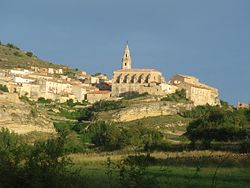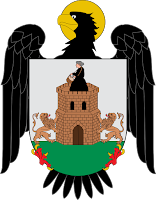TRONCHON
LOCAL TOURIST OFFICE( not aviable)
 |
| General View of Tronchon. |
Some years ago my Danish friend, Axsel and me were out to see for ourselves what my friend Antonio Benedicto of Linares de Mora had related to me about the Maestrazgo. I do not know who was responsible for whispering in my ear, 'Visit Tronchon and La Casa de Matilde!' Sometimes now I believe that the 'Whisperer' might well have been some sort of divine intervention. For what a surprise was in store for us both.
We had visited the 'Organos de Montoro' and returning to Villarluengo drove past and then followed a turning to the left and followed a rather difficult road to Tronchon some 17 kilometres distance. The village lay in a valley so that we had a pretty good view of it although from what we could gather there was very little of it to see. Around 1 kilometre before the village we came across a sign which read 'Fabrica de Queso' or 'Cheese Factory'. The entrance was through what appeared to be a farmyard with ducks and chickens wandering round and a huge cage which housed two enormous wild boar. At the far end there was the small cheese factory and waiting for us was the very pleasant Pilar, wife of the owner. We were shown round the spotless plant during which Pilar announced proudly that it had been in existence for 400 years, the proof being that Tronchon Cheese was mentioned twice in Cervantes classic Don Quixote. Then after buying some of their product we moved on the short distance to the village.
 |
| Pilar |
It was obviously not built with any four wheeled vehicles in mind so parking outside we navigated the cobbled streets on foot. I was immediately struck by the fact that everything seemed crooked. The roads, the crooked houses with their crooked balconies, just about everything.
 |
| One of the many crooked streets in Tronchon. |
Then, as if confirming my views, there came hobbling towards us a crooked man with a walking stick. Vaguely he directed us in the direction of the Casa Matilde.
 |
| Sign outside the Casa Matilde. |
 |
| Matilde |
For dining, we were told, we could use the downstairs room, her own dining room or a room next to the kitchen. We chose to be near the kitchen and immediately we were transported back some hundred years. The table was huge the chairs were more than comfortable and one wall was covered floor to ceiling with a dark wooden cupboard. Having some experience with such delightful places when asked by this smiling gentle woman what we would like, I replied, 'Just bring us food and wine.' And what a feast! Absolutely every product from the region. Delicious home grown tomatoes with olives, local ham and cheese of course from down the road. There were quails with white beans in a heaven blessed sauce. Oxtail, rabbit, cows cheek and much more. All washed down with an acceptable wine. Finally came the crowning glory. Good coffee together with a brandy that I had never heard of but that required Matilde to produce a step ladder to reach if off the top shelf of the enormous cupboard. As Axsel said, 'Well, Chris, I think that this is as near to heaven as we are going to get!'
 |
| A 'Masia' or fortified farmhouse one of several between 'Villarluengo' and Tronchon. |
 |
| The presentation by myself and John Deacon of a certificate of the excellency of the restaurant to the very special owner, Matilde. |





Comments
Post a Comment